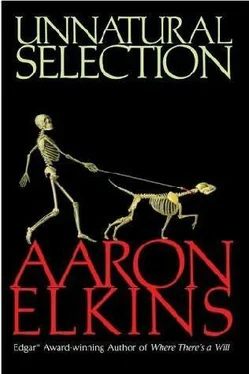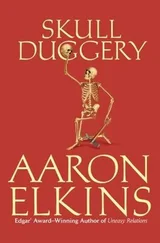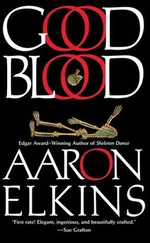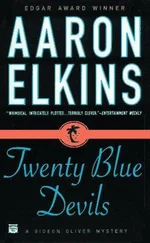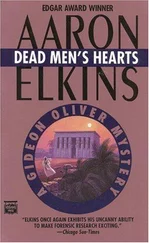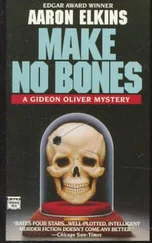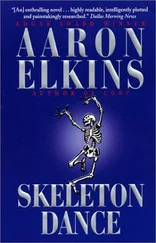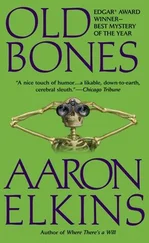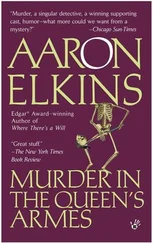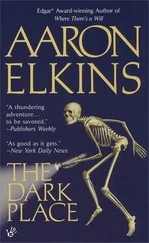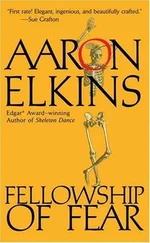Aaron Elkins - Unnatural Selection
Здесь есть возможность читать онлайн «Aaron Elkins - Unnatural Selection» весь текст электронной книги совершенно бесплатно (целиком полную версию без сокращений). В некоторых случаях можно слушать аудио, скачать через торрент в формате fb2 и присутствует краткое содержание. Жанр: Классический детектив, на английском языке. Описание произведения, (предисловие) а так же отзывы посетителей доступны на портале библиотеки ЛибКат.
- Название:Unnatural Selection
- Автор:
- Жанр:
- Год:неизвестен
- ISBN:нет данных
- Рейтинг книги:4 / 5. Голосов: 1
-
Избранное:Добавить в избранное
- Отзывы:
-
Ваша оценка:
- 80
- 1
- 2
- 3
- 4
- 5
Unnatural Selection: краткое содержание, описание и аннотация
Предлагаем к чтению аннотацию, описание, краткое содержание или предисловие (зависит от того, что написал сам автор книги «Unnatural Selection»). Если вы не нашли необходимую информацию о книге — напишите в комментариях, мы постараемся отыскать её.
Unnatural Selection — читать онлайн бесплатно полную книгу (весь текст) целиком
Ниже представлен текст книги, разбитый по страницам. Система сохранения места последней прочитанной страницы, позволяет с удобством читать онлайн бесплатно книгу «Unnatural Selection», без необходимости каждый раз заново искать на чём Вы остановились. Поставьте закладку, и сможете в любой момент перейти на страницу, на которой закончили чтение.
Интервал:
Закладка:
“You’re the pathologist,” Gideon answered. “What do you think?”
“I think we’re looking at a pretty obvious case of blunt-force trauma to the posterior parietal region, which, of course, goes along with the injuries on the radiograph.” He added a few observations for the microphone and pressed gently against Joey’s cheeks and temples. “No indications of superficial damage around the eyes, and the craniofacial skeleton seems undamaged. I expect we’ll find that the orbital hematomas are not distinct injuries, but a result of the parietal trauma, the force having been transmitted by the brain.”
Gideon nodded. “Contrecoup.”
“Contrecoup,” Merrill agreed.
They were talking about one of the most intriguing and least understood aspects of damage to the human skull and brain: the distinction between coup and contrecoup injuries. Generally speaking, when a moving object hit a stationary head-a blow with a hammer, say-the injury to the brain was going to be directly under the impact point. Whack a man hard enough on the occipital bone at the back of the head, and it will almost always be the occipital lobe of the brain that gets pulped. That was a “coup” injury. But when things were reversed, when a moving head hit a stationary object-in a fall, for example-the brain injury was likely to be at the opposite pole of the brain. Let a man fall off a catwalk onto stone paving and land on that same, rearward occipital bone, for example, and it would be the frontal lobe of the brain that got mashed into red jelly: a “contrecoup” injury.
Why this should be had puzzled scientists for centuries. In 1766 the Royal Academy of Surgeons in Paris had offered a prize for a definitive explanation of contrecoup. They didn’t get one then, and they still didn’t have one that satisfied everybody. Gideon, no expert on the brain, was willing to accept the common theory that, in a fall, the skull is traveling faster than the brain that is cradled inside it, so that when the back of the head hits the ground the brain continues to move, subjecting it to a piling-up of impact forces at the front.
Whether that was really the way it worked or not, contrecoup injuries were a fact, and he agreed with Merrill that they were looking at one now.
“Well!” exclaimed Merrill, and now he really did rub his hands together. “Let’s get on with it!” He stuck out a hand, into which Rajiv slapped the scalpel that he had waiting. Gideon moved a discreet step back. Rajiv, who was already wearing surgical gloves, now pulled up the mask that had been loosely tied around his neck.
Merrill, maskless and gloveless-contrary to both forensic and hygienic protocol-was a quick, sure worker, with no wasted movement. One hand, on Joey’s forehead, steadied his head against the block, while the other placed the scalpel blade behind the left ear. A moment’s pause to align the blade to the path that was to be followed, and the scalpel was deftly whipped over the top of the head, well in front of the scalp wound, and around to the back of the other ear: the standard coronal mastoid incision to expose the skull. With Joey dead so long, there was very little blood, but all the same Gideon’s stomach contracted, almost as if he could feel the blade slicing through his own scalp. This was at least the twentieth autopsy at which he’d been present, and before them he’d dissected two corpses in gross anatomy in graduate school, yet it was always the same. Would he never get used to them?
Probably not, but at least he no longer scandalized the autopsy staff by throwing up in the nearest sink, which he’d done the first time, in the San Francisco city morgue, a place he’d never again had the nerve to show his face.
With the cut made, the scalp was now essentially divided into two flaps. The rear one was pulled back and the front one vigorously tugged forward and down over Joey’s face, hair side down, depersonalizing him yet a little more and helping Gideon toward thinking of what he was looking at simply as a cranium, and not as the cranium of the nice kid he’d had dinner with the night before last. The yellowish, blood-flecked skull, its delicate, meandering coronal and sagittal sutures faintly visible, was now exposed from the ears up, and Gideon, took a step toward it for a closer look, interest overcoming aversion.
“Depressed fracture,” he said.
“Yes, that’s a bit of a surprise, isn’t it?”
Gideon agreed that it was.
The thing was, coup and contrecoup injuries weren’t the only way in which stationary heads that got in the way of moving objects usually differed from moving heads that ran into stationary objects. The skull fracture that was most likely to result from a fall was what is known as a linear fracture-or in common parlance, a crack-that might be anything from a single, relatively straight fissure, to a spiral network, to a maze of large and small cracks that broke the skull into a hundred pieces. A depressed fracture, on the other hand, was one in which the bone directly under the impact point was partially or fully separated from the rest of the skull and driven in, toward the brain, much as a hammer, striking a block of foam, wouldn’t crack it in half, but would leave a sunken imprint of itself in the block. And, naturally enough, such “imprints” were most likely to be the result of blows with instruments-hammers, rocks, ash-trays, or anything else that came to hand in a murderous moment. One didn’t often find depressed fractures in falls onto flat surfaces.
One did, however, occasionally find them in falls directly onto edged or pointed objects.
Which is what Merrill concluded had happened. “His head must have struck something when he fell-something in addition to the paving, I mean. Would there have been any relatively small objects lying on the ground that his head might have hit? Rubble, rocks…?”
“I never did see the body in place, so I don’t know exactly where it landed,” Gideon said, “but yes, there was a lot of stuff lying around in the passageway: tools, construction material, pottery shards-”
“Well, there it is, then. It might have been anything: a rock, or
…” He paused, seeing Gideon’s scrutiny growing more intense. “I say! You can probably tell what it was from the shape of the wound, can’t you?” he asked eagerly. Merrill was something of a fan of Gideon’s, and had been from the first, having earlier read several of his papers in the Journal of Forensic Sciences and some of the more sensational articles in the general media about his work with skeletal remains. And so he tended to expect more than Gideon could always deliver.
“Well, sure, sometimes you can,” Gideon said, shaking his head, “but this one? I don’t know, it’s not a very well-defined imprint. Doesn’t look like anything to me at this point. No, I wasn’t looking at the depressed part, I was looking at the fracture pattern around it, trying to make out…”
His voice faded away, as it frequently did when he was studying bones or thinking about them. And there was something about this one that intrigued him. Sometimes the impacting force of whatever had caused the depressed fracture stressed the surrounding bone enough to create a network of radiating cracks around the depression, and that was what had apparently happened with Joey. The depressed fracture itself was an irregular disk of bone, no more than an inch across, and driven only a couple of millimeters below the rest of the skull, but it lay in a spider-web of cracks that ran jaggedly off in every direction, over much of the skullcap; the calvarium, as it was known. But unless he was mistaken…
Merrill had waited politely for a minute while Gideon stood unmoving, then for a second minute, and then exchanged a what-in-the-world-is-the-man-doing look with Rajiv, who shrugged.
Читать дальшеИнтервал:
Закладка:
Похожие книги на «Unnatural Selection»
Представляем Вашему вниманию похожие книги на «Unnatural Selection» списком для выбора. Мы отобрали схожую по названию и смыслу литературу в надежде предоставить читателям больше вариантов отыскать новые, интересные, ещё непрочитанные произведения.
Обсуждение, отзывы о книге «Unnatural Selection» и просто собственные мнения читателей. Оставьте ваши комментарии, напишите, что Вы думаете о произведении, его смысле или главных героях. Укажите что конкретно понравилось, а что нет, и почему Вы так считаете.
